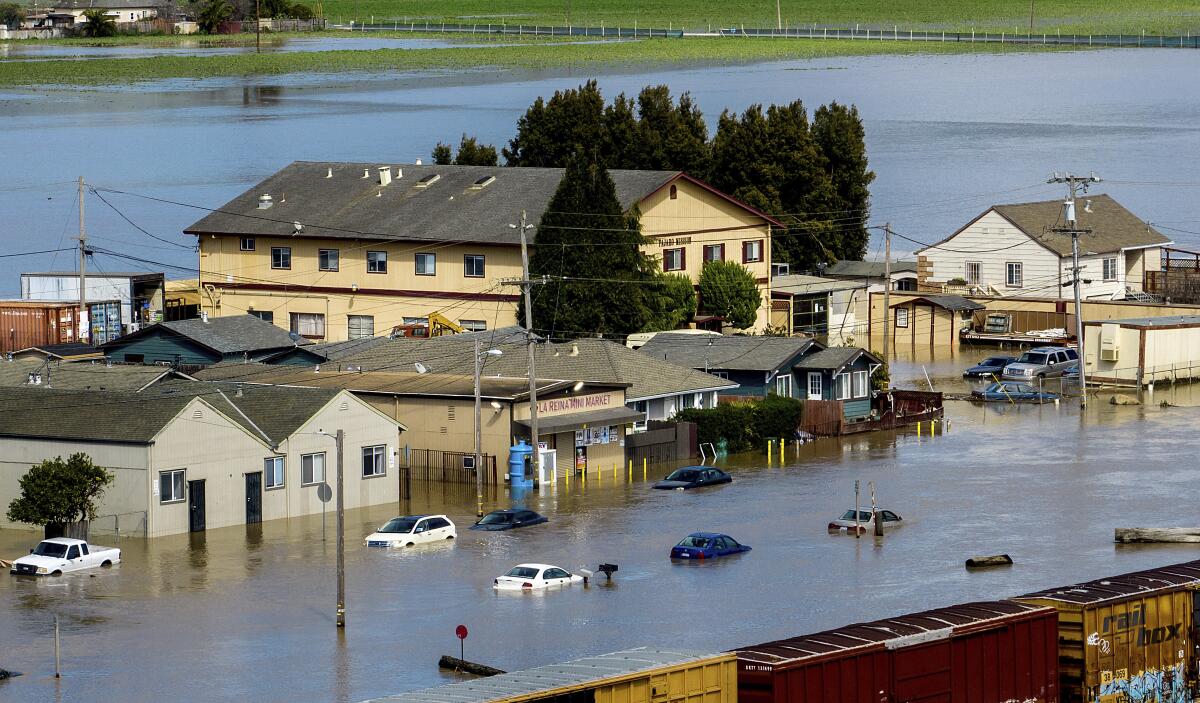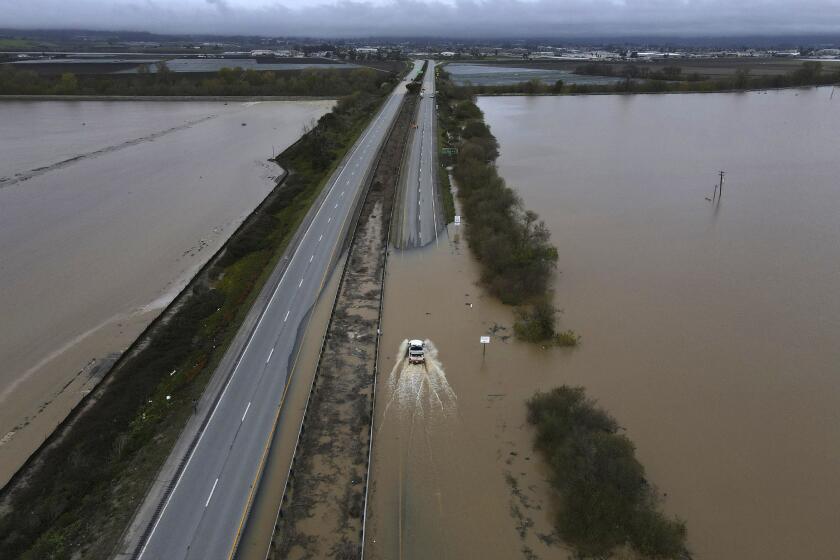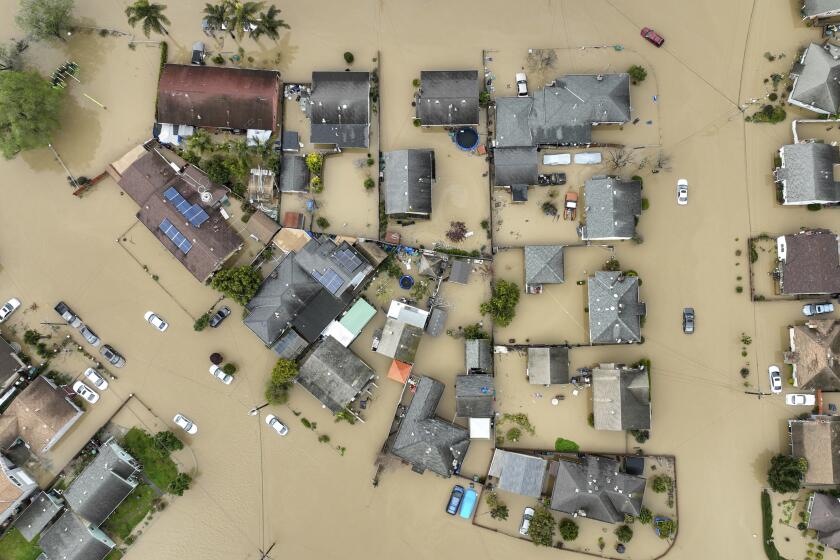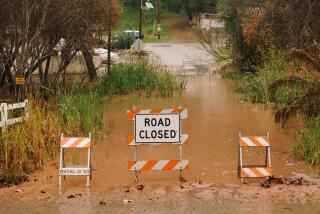‘Probable inundation’: Salinas River communities brace for flooding, crop losses

Monterey County residents are bracing for yet another onslaught of floodwater as an incoming storm threatens to overflow the Salinas River, imperiling the lives of farmworkers and crops and triggering evacuations.
“Projections now include a probable inundation of roadways between the Monterey Peninsula and the rest of the county,” officials said hours before an atmospheric river was forecast to hit the agricultural region. More than 10,000 people there remained under evacuation orders and warnings as of Tuesday.

The news comes only days after a levee breach on the nearby Pajaro River triggered massive flooding and prompted dozens of water rescues. The breach left much of Pajaro — a town of about 1,700 people, mostly farmworkers — under several feet of water.
Residents and officials fear that flooding along the Salinas River could further threaten the region. By late afternoon Monday, the river had surpassed its flood stage at Salinas, Bradley and Spreckels, according to the National Weather Service.
“Crop fields in the Salinas Valley and the Pajaro Valley area are experiencing significant flooding and inundation at this point,” Norm Groot, executive director of the Monterey County Farm Bureau, said during a news briefing. “Salinas Valley flooding appears to be greater along the Salinas River than what we experienced in January, with more impacts to fields and rural roadways.”
For years, experts had been warning Monterey and Santa Cruz County that the levee along the Pajaro River could fail.
Groot said January’s storms — which included nine back-to-back atmospheric rivers — affected more than 15,000 acres and contributed to more than $330 million worth of farm losses in the area. The current storms are expected to affect even more acreage, he said, particularly areas west of the city of Salinas.
“There will be more crop losses as areas that have not experienced flooding are now experiencing it for the first time,” Groot said.
Meanwhile, the already-flooded Pajaro Valley has “many acres of crop fields that are currently underwater due to the levee break over the weekend, and waters may not recede until that levee break can be reconstructed,” he said. “This poses a serious threat to crop production for the entire spring season and possibly longer.”
Among the imperiled crops are strawberries, raspberries, lettuce and broccoli, said Monterey County Agricultural Commissioner Juan Hidalgo. The Salinas Valley is sometimes referred to as the “salad bowl of the world.”
“Some of the damages we’re seeing now are quite alarming,” Hidalgo said. “We are seeing much bigger damages to our agricultural area than we did during the January storms.”
Floodwaters are not only inundating fields and keeping growers from their crops, but they will also necessitate testing for pathogens after the waters abate, Hidalgo said — a process that could take up to 60 days.
“Depending on how quickly waters recede, we might be looking at reduced yields from the rest of the season,” Hidalgo said. “From experience in previous flooding that we have seen in the past, we’re looking at anywhere from 30% to 50% yield losses.”
A levee failure on the Pajaro River in Monterey County triggered massive flooding and prompted hundreds of evacuations and dozens of water rescues.
Also concerning are the potential impacts for farmworkers in the area, many of whom have been evacuated and could go without work while waiting for fields to go back into production.
“Our hearts are aching right now,” said Kim Stemler, executive director of the Monterey County Vintner and Growers Assn. The county’s wine industry cultivates 43,000 acres of wine grapes — about the same amount as Napa County — and employs around 7,200 people, with an economic impact of about $1.4 billion, she said.
“Our wine community is multigenerational, cares about our land, our employees and our community, and it’s very painful for all of our folks in wine to watch how many individuals and families are really devastated,” she said.
Fortunately, she said, many vineyards are at higher elevations and many vines are still dormant or just starting to bloom, so they may be spared from the floods. But some wineries have lost culverts and pumps and suffered business income losses as people avoid the area.
“We really want to make sure that the employees and the individuals and families that have been displaced get whatever support they need, get it very quickly, and that those that haven’t been able to work because of these storms — that have lost income very, very quickly — get whatever kind of relief they can,” she said.
The latest storm will create flooding concerns along much of the California coast and Central Valley, and over the southern Sierra Nevada foothills.
Not only have many residents been displaced from flooding and evacuations, but the drinking water in the area is not currently potable, said Monterey County Undersheriff Keith Boyd. One school, two mobile home parks and about 800 homes in Pajaro are under “do not drink” orders because of the floods.
Adding to the challenge is that the region’s water managers are making critical releases from nearby Lake Nacimiento to make room for more inflows from the storm, officials said. That’s contributing to the amount of water in the Salinas River, which is already nearing capacity.
Groot, of the Monterey County Farm Bureau, said the conditions highlight the need for more comprehensive management of levees and other channels that have seen flooding from the storms.
The Salinas River channel was “not adequately maintained in recent decades, and capacity flow rates have been severely reduced due to sandbar buildup, excessive vegetation — particularly nonnative vegetation that has overgrown in many reaches of the river channel,” he said.
Flash flood warnings remain in effect for parts of Santa Cruz, Monterey, Tulare and Sonoma counties, according to the National Weather Service.
Jeremey Arrich, flood management division manager at the California Department of Water Resources, said Monday that the agency has deployed crews to assist with repairing the levee breach at Pajaro, including laying rocks and boulders.
“Public safety will take priority in any actions moving forward to protect local communities, and again the situation is dynamic and evolving, and we have a lot of resources across the state with our local partners out there to address that situation,” he said.
A second levee breach along the Pajaro River has alleviated some pressure, said Monterey County water resources engineer Shaunna Murray, but there is no clear timeline for when it will be fixed.
“We’re going to see systems continue to stay high and be wet, so we’re going to have to continue our vigilance on watching the rivers and preparing,” Murray said. “When these systems come in, and the system is already very wet, the flows really do not decrease for quite some time.”
On the Salinas River, peaks began around Spreckels late Sunday night and early Monday morning, Murray said. Additional peaks are expected from the Arroyo Seco tributary, which will hit the lower Salinas River in the next few days, followed by the waters from the Upper Salinas and the San Lorenzo Creek after that.
Undersheriff Boyd said officials were preparing for high-water floods, including readying swift water rescue teams.
But though many efforts are in place to keep people safe from the storms, the crops are largely on their own, Hidalgo said.
“Plants can be quite hardy, and they can recover, but if they stay underwater for too many days it’s definitely going to have some very significant impacts to those growers,” he said.
More to Read
Start your day right
Sign up for Essential California for news, features and recommendations from the L.A. Times and beyond in your inbox six days a week.
You may occasionally receive promotional content from the Los Angeles Times.










